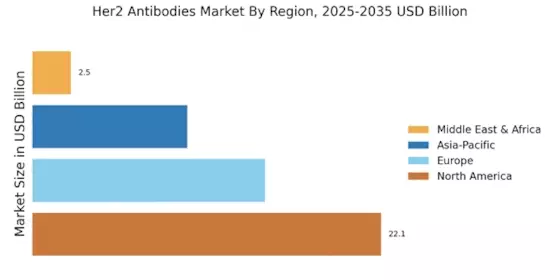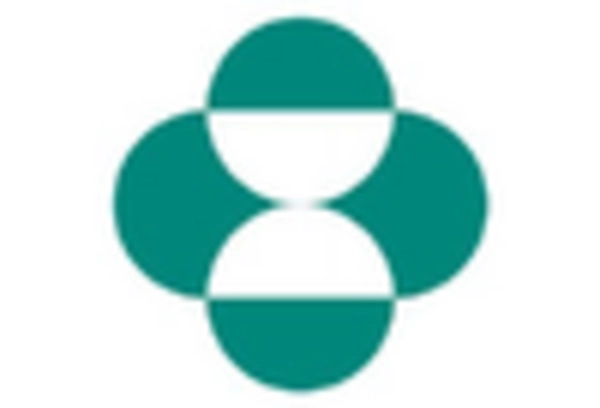Advancements in Targeted Therapies
Advancements in targeted therapies represent a significant catalyst for the Her2 Antibodies Market. The development of novel Her2-targeted agents, such as trastuzumab and pertuzumab, has revolutionized treatment protocols for HER2-positive breast cancer. These therapies have demonstrated improved survival rates and reduced recurrence, which is critical for patient management. The market for Her2 antibodies is projected to expand as ongoing research yields new formulations and combinations that enhance efficacy. Furthermore, the integration of biomarker testing in clinical practice ensures that patients receive the most appropriate therapies, thereby driving demand for Her2 antibodies. As the landscape of cancer treatment evolves, the Her2 Antibodies Market is poised for growth, reflecting the ongoing commitment to innovation in oncology.
Growing Investment in Cancer Research
The growing investment in cancer research is a crucial driver for the Her2 Antibodies Market. Increased funding from both public and private sectors has accelerated the pace of research and development in oncology, particularly for HER2-positive cancers. This influx of capital supports clinical trials and the exploration of new therapeutic avenues, which is essential for the advancement of Her2 antibodies. According to recent reports, funding for cancer research has seen a significant uptick, with billions allocated annually to various initiatives. This financial commitment not only fosters innovation but also enhances collaboration among research institutions, pharmaceutical companies, and healthcare providers. As a result, the Her2 Antibodies Market is likely to benefit from a robust pipeline of new therapies and improved treatment protocols.
Regulatory Support for Innovative Therapies
Regulatory support for innovative therapies plays a vital role in shaping the Her2 Antibodies Market. Regulatory agencies are increasingly recognizing the need for expedited approval processes for breakthrough therapies, particularly in oncology. This trend is evident in the approval of several Her2-targeted therapies that have received fast-track designations, allowing for quicker access to patients. The supportive regulatory environment encourages pharmaceutical companies to invest in the development of new Her2 antibodies, knowing that their innovations may reach the market more swiftly. Additionally, the emphasis on patient-centric approaches in regulatory frameworks aligns with the goals of the Her2 Antibodies Market, fostering an ecosystem conducive to growth and innovation. As regulatory bodies continue to adapt to the evolving landscape of cancer treatment, the market is likely to see enhanced opportunities for new entrants.
Increasing Incidence of HER2-Positive Breast Cancer
The rising incidence of HER2-positive breast cancer is a pivotal driver for the Her2 Antibodies Market. Recent statistics indicate that approximately 20 to 25% of breast cancer cases are HER2-positive, necessitating targeted therapies. This growing patient population fuels demand for Her2 antibodies, as they are integral to treatment regimens. The increasing awareness and screening for breast cancer further contribute to the identification of HER2-positive cases, thereby expanding the market. As healthcare systems prioritize early detection and personalized treatment plans, the Her2 Antibodies Market is likely to experience substantial growth. The focus on improving patient outcomes through effective therapies underscores the importance of Her2 antibodies in oncology, making this driver particularly influential in shaping market dynamics.
Rising Awareness and Education on HER2-Positive Breast Cancer
Rising awareness and education regarding HER2-positive breast cancer significantly influence the Her2 Antibodies Market. Increased public and professional knowledge about the disease has led to earlier diagnosis and treatment, which is crucial for improving patient outcomes. Educational campaigns and advocacy efforts have empowered patients to seek timely medical intervention, thereby increasing the demand for Her2 antibodies. Furthermore, healthcare professionals are becoming more adept at identifying HER2-positive cases, which enhances treatment planning and patient management. The proliferation of information through various channels, including social media and healthcare platforms, contributes to a more informed patient population. As awareness continues to grow, the Her2 Antibodies Market is expected to expand, driven by the need for effective therapies and personalized treatment options.


















Leave a Comment